Humans are incredibly diverse – and it’s marketing’s job to respect, engage, and nurture that.
Expanding a B2B business from English-only strategies to regional, multi-language campaigns can absolutely be the turning point of your success. In fact, it’s hard to believe that not everyone’s taking advantage of it.
Mass-market, English-only campaigns cost a ton of money. And, with today’s expectation for a high level of personalization across the customer experience, they don’t really bring much to the table.
Multi-language ad campaigns are more effective as a whole and can even help save you money over time.
Why?
Because diverse markets help diversify income and lead to long-term business sustainability.
As more people throughout the world recognize your brand, you have the opportunity to build brand authority and reduce customer acquisition costs.
This is especially true if you’re in the B2B world. Larger deal sizes and complex buyer committees mean longer sales cycles and more opportunities to either impress or irritate local audiences.
And one of the best ways to turn this opportunity into reality is through the strategic use of localized Google Ad campaigns.
Because Google Ads drive conversions quickly, you can show proof of concept to new markets, which establishes a great starting point for long-term international expansion and increased ROI.
Let’s now dive into how this all works.
Localization > Translation
Before you load up 100 new Google Ad campaigns for your B2B target market, there’s one crucial concept to integrate into your processes: Focus on localization over translation.
Here’s a basic overview of the difference:
- Translation involves putting the exact keyword into Google Translate or Deepl and getting literal, word-for-word translations back. I don’t know if you’ve ever tried that when traveling around, but it doesn’t get you much further than asking for directions to the nearest restroom. And when applied to PPC, chances are that directly translated keywords either don’t have search volume or mean something entirely different when used in search (bringing about search intent mismatch).
- Localization is the act of identifying keyword intent and finding an equivalent with search volume in the target language of your choice. To do this, you’ll need to deeply understand the local market, its nuances, and the language they use.
Remember, local competitors are already matching local buyer expectations, so if you don’t start off by already doing that better, you won’t have much success. You can’t copy/paste global campaigns and then sit back, wondering why you’re not seeing the conversions roll in.
Mass website translation alone is not international expansion, and it’s often an efficient use of time and resources when there’s no localized strategy to back it up.
Steps For Developing A Multilingual PPC Strategy For B2B
Developing a multi-language Google Ad strategy takes time, but with the right approach, you can see success rather quickly.
Here, I’ll go through eight steps to help you scale your B2B business across multiple languages and regions.
Step 1: Localize Your Operations
Many companies successfully localize their marketing but forget to make changes when it comes to sales and operations (which actually need to be in place before marketing begins in order to guarantee ROI from the marketing efforts).
The reality is that people buy things differently in different countries. For example, in the US, you can purchase almost anything with a credit card, but in Germany, people don’t use them and much prefer payment by invoice.
The buying cycle in Germany is also much longer in B2B because the work culture is highly process-oriented.
If you don’t localize those areas and expect leads to talk to a salesperson in English with a 9-hour time difference, you definitely won’t do well in closing those leads that marketing has worked so hard to get.
To truly be successful when entering new markets, here are the elements you’ll want to localize:
| Brand Strategy | Buyer Personas | Content | Operations |
| Your USPs | Pain points | SEO keywords | Sales and customer service |
| Your competitors | Buying process & customer journey | Important words and phrases | Product |
| Messaging & cultural relevance | Buying obstacles and how to overcome them | Website in the local language | Payment process |
Step 2: Localize Market Research And Competitors
The next essential step when scaling your multi-language B2B Google ads strategy is to spend time actually learning about your target audience in local markets.
Rather than copy/pasting a generic global strategy, you need to see what brands resonate with locals and which local companies are seeing success.
To help you navigate this process, follow these steps:
- Start by exploring the competition within your chosen market and see what they’re doing to market to local audiences. You can gain access to key metrics using tools like Semrush Advertising Research to see if your competitors are running any paid ads and what keywords they’re bidding on.
 Screenshot from Semrush, July 2023
Screenshot from Semrush, July 2023To give you a visual idea, the screenshot above shows an example of PPC competitor research solely in the Swedish market.
This is useful because you’ll likely see that not all competitors have localized sites, which is an opportunity that major competitors have missed – good news for you and your niche!
- Then use Semrush Advertising Research to dig into the keywords competitors are bidding on and the types of pages they are using to target these keywords. It’s important to note that some companies may offer a similar service or product but may not necessarily be direct competitors, so you’ll need to filter out any who don’t match.
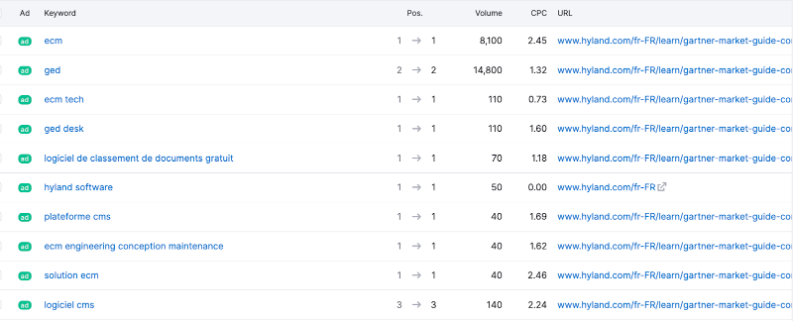 Screenshot from Semrush, July 2023
Screenshot from Semrush, July 2023From this screenshot above for the French market, you can see that one competitor is bidding on a mix of French and English keywords, such as their brand “hyland software.”
- Lastly, take a look at what the competitor’s ad copy looks like. This will give you insight into the types of phrasing used and give you ideas for what you can improve on (as it should always be the goal to surpass competitors, not just match them).
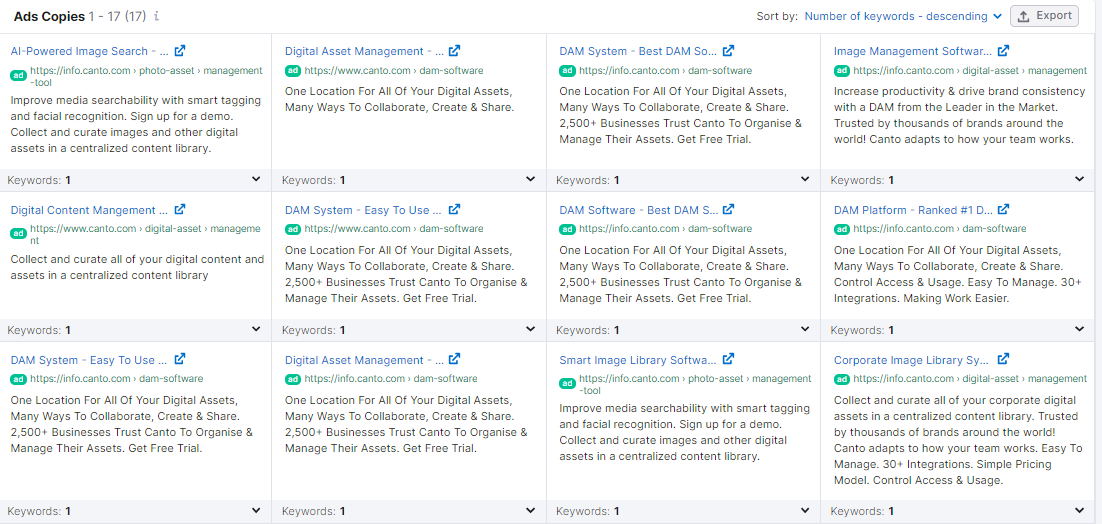 Screenshot from Semrush, July 2023
Screenshot from Semrush, July 2023This particular example shows how the competitor has only used English ads for the Norwegian market.
So there’s again an opportunity for you to offer a better customer experience through localization and target local keywords so that your Google Ads have a better quality score.
Overall, the more thorough you are with localized market and competitor research, the better you’ll be prepared to implement tactics that enable you to outpace them.
Step 3: Localize PPC Keyword Research
All local markets have some element of variation between them, which means that you can’t directly translate keywords. Direct translations don’t capture the differences between search intent among various languages, dialects, and regions.
This is where the concept of localization becomes absolutely crucial.
To effectively localize keywords, follow this process:
- Adapt keywords for localized PPC strategies by identifying keywords that match search intent and have search volume. If you don’t check local search volume and consider similar phrases, it’s easy to lose valuable conversions due to linguistic nuances.
- Interestingly, don’t overlook the power of English keywords as well as localized keywords. Some markets may have English keywords with more search volume than the localized language, and you’ll need to ensure you have ads running for both languages. I’ve found this to be especially true for the B2B tech industry that uses English phrases within the local language.
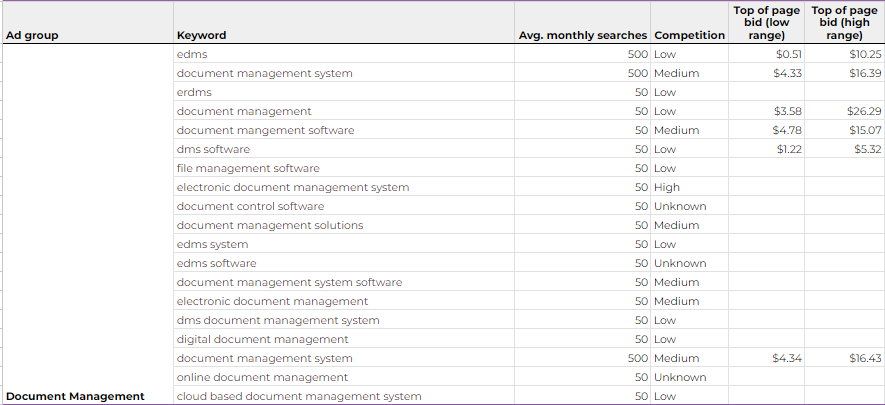
 Screenshots from author, July 2023
Screenshots from author, July 2023For example, in the screenshots above, you can see that document management keywords have been compiled in both Swedish and English. All the keywords came back with different search volumes, but there’s enough to warrant campaigns in both languages.
Note that the keyword “EDMS” is not used in Sweden, so consequently isn’t included in the chosen keywords for Sweden – hence the importance of understanding the market nuances through localization!
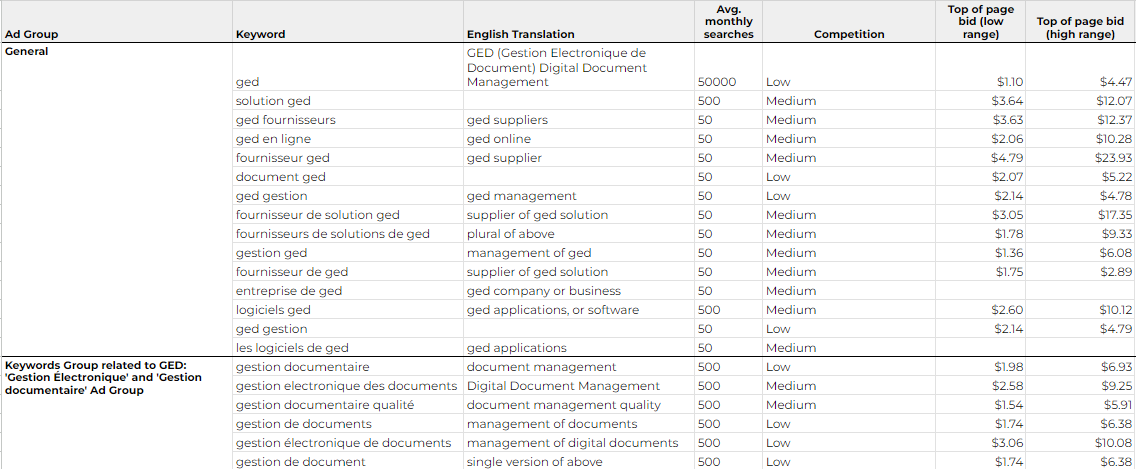 Screenshot from author, July 2023
Screenshot from author, July 2023Another example of the importance of localization is the term “GED,” a common French abbreviation of the word “gestion électronique de documents.”
This is why you can’t just simply translate English keywords, as some of the highest search volume and conversion-focused keywords may end up being excluded from your strategy.
Step 4: Localize PPC Ad Copy
Ad copy localization is where it pays to collaborate with someone who speaks the native language. You’ll need to localize ad copy for the following:
- Brand messaging guidelines.
- Google Ad character limits.
- Local unique selling points (USPs).
- Local pain points.
- Local cultural nuances, both within the language and keywords targeted.
If you were to write ad copy for some of the French keywords compiled in the previous section, it might look like this:
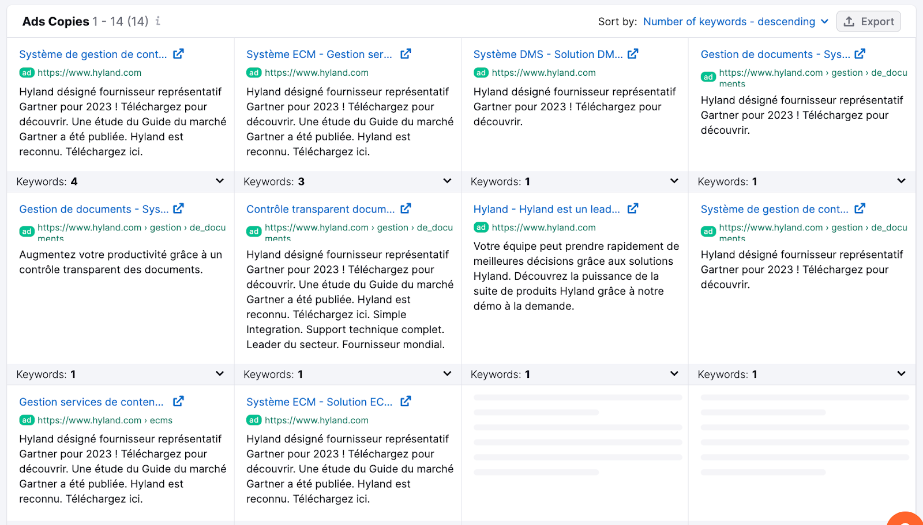 Screenshot from Semrush, July 2023
Screenshot from Semrush, July 2023Step 5: Localize PPC Landing Pages
The copy across the pages needs to contain local keywords in order to maintain a high-quality score (the higher the quality score, the lower the bid costs are).
You’ll also need to focus on addressing the different issues or pain points audiences have across different regions.
To stand out from your competition, prioritize your USP within that particular market. Creative angles can help engage new markets, especially when in comparison with local competitors.
Furthermore, make sure to add some social proof to your landing page. This can be anything from case studies, testimonials, or use cases that match the target audience market. Social proof, in particular, helps your message resonate more strongly.
Step 6: Organize PPC Ad Groups Based On Purchase Intent Stage
Once you have your landing pages localized, you’ll want to organize ad groups based on which part of the sales funnel they’re in, i.e. their level of purchase intent.
A successful Google Ad strategy creates content for and targets keywords based on both transactional and informational search intent.
To organize your campaigns accordingly, use the following steps:
- Define your keywords based on transactional search intent. These will be keywords that precisely describe your products and services and are most oriented toward direct lead generation (or contact with sales).
 Screenshot from author, July 2023
Screenshot from author, July 2023For example, the keywords above describe the main services that a compliance management company wants to run ads for. They’re very conversion-focused and capture the user when they’re looking to make a purchase.
- Then, define your keywords based on informational search intent. These will be keywords that describe topics that your audience needs information on and are relevant for selling your products and services, but your audience isn’t quite ready to buy yet. These types of ads are particularly useful for nurturing users toward conversion in combination with retargeting campaigns.
Splitting out campaigns like this allows you to manage budgets better, as informational keywords tend to be higher in value due to search volume and broadness. However, you still want to own this space to help nurture users toward conversion, so we do need ads here.
And with the correct bid strategy, you can ensure you get the most clicks within your budget. Targeting keywords with both types of intents is more successful than just going for direct conversions, as that can limit your return on investment (ROI) potential over time.
Step 7: Retarget Users To Choose Your Brand Once They’re Ready To Purchase
Once you’re organized, make a strategy for retargeting campaigns. To give you a visual, retargeting display ads often have a structure that looks like this:
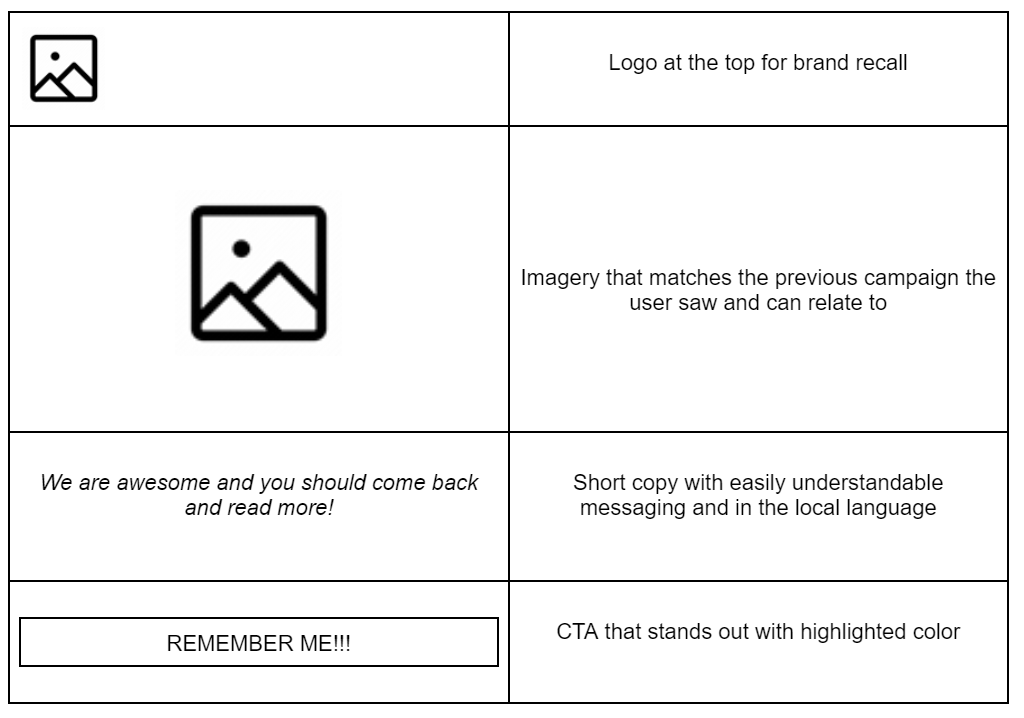 Image created by author, July 2023
Image created by author, July 2023Even though there typically is a CTA, remember that retargeting display campaigns aren’t for directly generating clicks.
When combined with the full funnel campaign approach, they’re meant to keep your brand and products/services top of mind.
Essentially, display ad retargeting is basically like going, “Hey, I’m here whenever you need something. Don’t forget me!”
So you’ll often see an increase in direct website traffic and branded keyword search volume from display ads, as opposed to direct click conversions.
Step 8: Track Multilingual PPC Performance Per Individual Markets
Finally, make sure that you set up conversion tracking for each market, not just globally.
This enables you to determine which markets perform best and where you might need to improve. Some ways to do this include ad campaign performance KPI tracking and conversions per region, such as shown in the below example images:
 Screenshots from author, July
Screenshots from author, July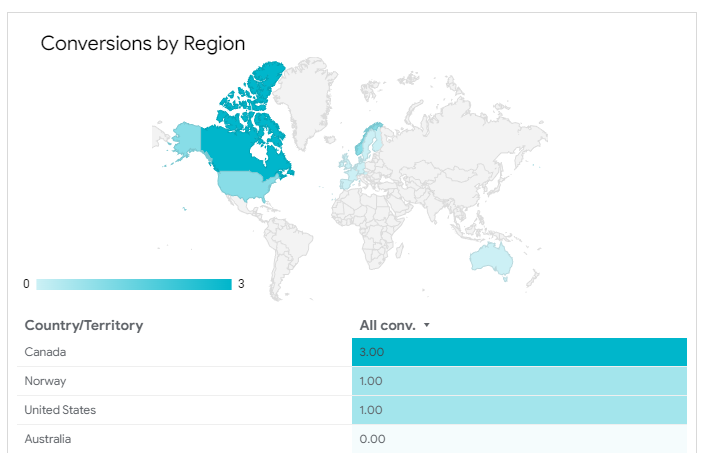
Use Localization Within Your Multilingual PPC Strategy To Convert
If you want to expand your B2B business into international markets with Google Ads – and truly see your efforts pay off – you need to stop the Google Translation use and focus on holistically localizing your strategy.
In doing so, you have the opportunity to make a real, valuable impression on your target audience by matching local customer expectations while also gaining their trust and building your customer base.
While this process does require more effort, it’s a whole lot more effective for generating leads and ensuring that they actually close.
More resources:
- How To Create B2B Google Ads Campaigns That Nurture And Convert Customers
- Scale Your B2B Lead Generation With Discovery Ads
- PPC 101: A Complete Guide to Pay-Per-Click Marketing Basics
Featured Image: Billion Photos/Shutterstock





